|
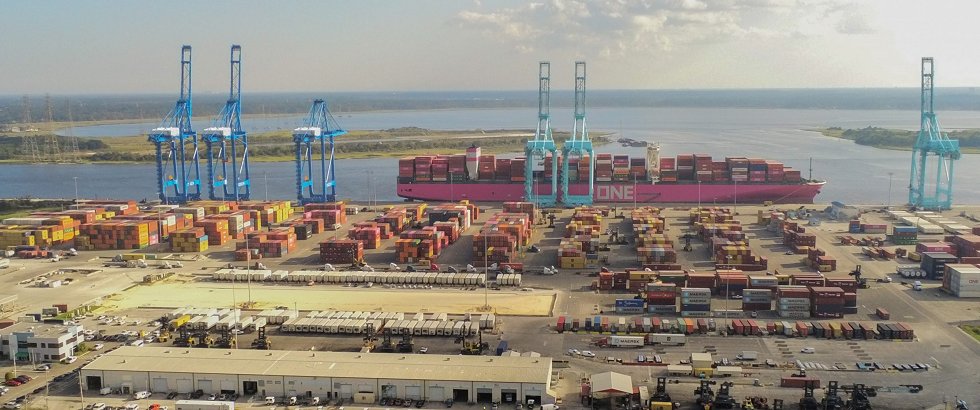
SSA Jacksonville Container Terminal Expansion Project Reaches Halfway Mark
Dec. 22, 2023 - SSA Marine has reached the halfway point in a $72 million project to expand and modernize the SSA Jacksonville Container Terminal. Located at JAXPORT’s Blount Island Marine Terminal, the SSA Jacksonville Container Terminal project is a public-private partnership between the port and SSA Marine.
The phased construction project began in 2022, with the company recently completing four of the project’s eight phases, including installing upgraded terminal lighting and a redesigned terminal gate system, as well as paving nearly 40 acres with heavy-duty asphalt. Six new outbound truck lanes are also currently under construction and scheduled to open in February 2024, with improvements to the terminal’s six inbound lanes scheduled for completion in late 2024.
Currently, the SSA Jacksonville Container Terminal features newly rebuilt berths and a 47-foot deepwater shipping channel. Upon completion in 2025, the facility’s upgraded yard will feature 97 acres of newly paved asphalt to accommodate taller stacks of loaded containers, with the capability to further expand the terminal to 120 acres as needed.
In 2025, the facility will be able to accommodate nearly 500,000 TEU annually, a 150% increase over its current throughput. The increased capacity will bring JAXPORT’s total TEU capability across all terminals to more than two million TEUs annually, approximately double its current throughput.
“SSA Marine is proud to have been a JAXPORT partner for more than 40 years,” said Lauren Offenbecher, president of SSA Marine’s conventional division. “This partnership has created tremendous opportunities for us to not only invest in the future of JAXPORT, but also to service the growing needs of our customers in the region. We’re looking forward to continuing to support JAXPORT’s growth trajectory for years to come.”
In total, nearly $140 million in improvements are currently underway to modernize the SSA Jacksonville Container Terminal. In addition to the $72 million in yard improvements, the company is also investing in three new 100-foot gauge electric container cranes, one of which is in service and two of which are in the process of being commissioned. The new cranes will double the terminal’s total number of post-Panamax cranes to six. SSA Marine and JAXPORT have also received federal grant funding for the purchase of more than $31 million in new eco-friendly cargo-handling equipment, including hybrid-electric rubber-tired gantry (RTG) cranes and Tier 4 top pick container handlers for the terminal.
“The investments SSA Marine is making in Jacksonville allow us to build on the momentum we are experiencing and maximize the efficiencies created by our 47-foot channel,” said JAXPORT CEO Eric Green. “As cargo volumes in the Southeast US continue to grow, the SSA Jacksonville Container Terminal provides a modern and efficient facility that will benefit our customers and community well into the future.”
SSA Marine is among the world’s leading independent, privately held marine terminal operators, with activities at more than 250 terminal facilities throughout the U.S., Canada, Mexico, Central America, South America, and Asia.
SOURCE: JAXPORT |
|
|
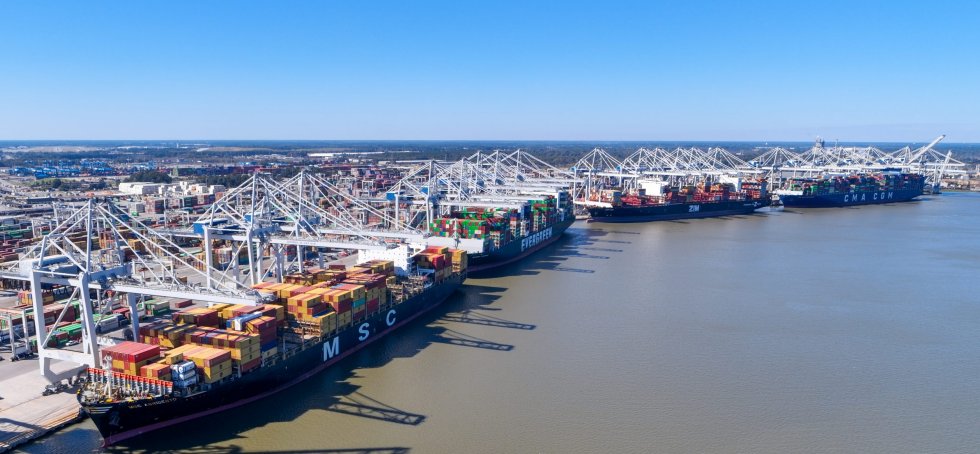
All Berths Open for Business at Port of Savannah; Dock Renovations, Crane Commissioning Complete
Nov. 17, 2023 - The Port of Savannah’s Garden City Terminal handled 129 container ship calls last month, an increase of 26 percent compared to October 2022.
“For the first time in two and a half years, all berths are open at Garden City Terminal for faster, more efficient cargo handling,” said Georgia Ports Authority President and CEO Griff Lynch. “We appreciate our customers’ patience during the renovation of Berth 1, and look forward to providing the world-class vessel service they have come to expect from GPA.”
The Port of Savannah handled 449,000 twenty-foot equivalent container units in October, for its fourth-busiest October ever and a 5 percent increase over the same month in 2019, the most recent year not affected by the pandemic.
“Our infrastructure planning efforts will be realized with Berth 1’s opening and we now have ample berth capacity to handle demand,” said GPA Board Chairman Kent Fountain. “This timing is important for the holiday season and last-minute orders.”
Containers moved by rail grew by 9 percent at Garden City Terminal in October, an increase of nearly 4,000 containers to 47,750. At the Appalachian Regional Port, rail cargo grew by 22 percent last month for a record October.
For the fiscal year to date since July, the Port of Savannah has handled 1.7 million TEUs, a decrease of 18 percent or 382,580 TEUs compared to the same period in FY2023, which saw some of the busiest months in GPA history.
In Roll-on/Roll-off cargo, GPA handled 67,500 units of autos and machinery in October, down 5.8 percent or 4,160 units compared to the same month last year. For the fiscal year to date, GPA has handled 271,364 Ro/Ro units, up 17 percent or 39,500 units.
Georgia’s ports and inland terminals support more than 561,000 jobs throughout the state annually, and contribute $33 billion in income, $140 billion in revenue and $3.8 billion in state and local taxes to Georgia’s economy.
SOURCE: Georgia Ports Authority |
|
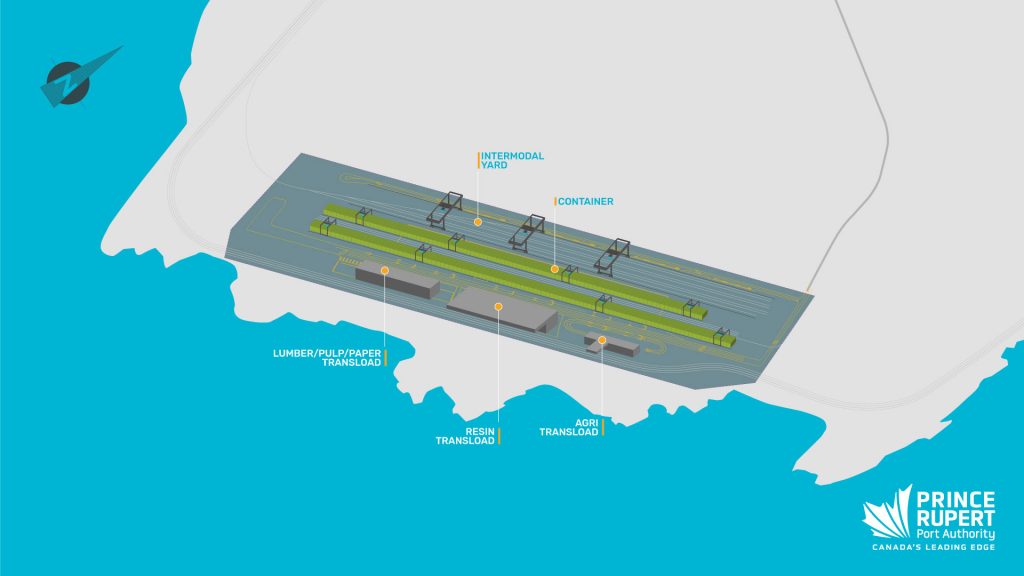
Prince Rupert Port Authority to Begin Construction On $750 Million Export Logistics Project
Oct. 23, 2023 - The Prince Rupert Port Authority (PRPA) is commencing construction on the Ridley Island Export Logistics Project (RIELP), an innovative large-scale logistics project that will provide expanded capacity and capabilities for rail-to-container transloading of multiple export products at the Port of Prince Rupert. The investment promises to deliver critical trade infrastructure that will improve supply chain resiliency, strategic market access and enhanced competitiveness for Canadian exports.
The project will consist of a 108-acre greenfield development on Ridley Island that will commence operation in Q3 2026. Ray-Mont Logistics will develop and operate facilities that provide transloading service capacity for 400,000 TEUs (twenty-foot equivalent units) for agricultural, forestry, and plastic resin products. Ray-Mont currently operates a successful multi-product transload facility on a temporary Ridley Island location that has proven the export transload concept in Prince Rupert.
“Ray-Mont is committed to developing and expanding our successful export transload business in Prince Rupert and believes that RIELP represents an ideal platform to significantly increase the scale, efficiency and level of service to our existing and future customers,” said Charles Raymond, President & CEO, Ray-Mont Logistics.
“RIELP will be unique in North America in terms of its ability to simultaneously handle multiple unit trains of varying commodities and significantly decarbonize the logistics chain,” Raymond added.
The project will also include an expansion of the existing Ridley Island Road Rail Utility Corridor that will facilitate unit trains 10,000 feet in length with direct access to the site from the CN network. The transload facilities will be connected to Fairview Container Terminal by direct private road access, the 5-kilometer Fairview-Ridley Connector Corridor, ensuring all product movements will be within PRPA jurisdiction and fully avoid public infrastructure. The full electrification of transload facilities, optimization of rail, and the minimal truck drayage cumulatively represent a significant step forward in decarbonizing Canada’s export supply chains.
RIELP will provide new and innovative capacities for Canadian exporters to Asia Pacific markets. The project’s large scale, unit train capabilities, access to available empty containers, and proximity and integration into container terminal operations make it a unique model that promises the ability to deliver significant new service offerings to exporters that will greatly improve the quality, cost and reliability of container supply chains.
The project’s development is fully aligned with PRPA’s land use plan and intermodal development strategy. In addition to its commercial advantages, RIELP will result in stronger volumes for loaded export containers moving through the Port of Prince Rupert and a more sustainable balance in its intermodal import and export trade. The development of increased logistics capacity is seen by PRPA as a strategic prerequisite to supporting the stability of existing and future container volumes through Prince Rupert, and the trade, employment and economic opportunities they support.
Total capital investment in RIELP will be approximately $750 million, and is being provided by PRPA, Ray-Mont Logistics, CN, the Government of Canada, and the Government of BC.
Canada’s National Transportation Corridor Fund is providing $64.8 million and the Province’s Stronger BC program is providing $25 million toward the project.
PROJECT FACTS
- Estimated capital investment: $750 million
- Construction start: October 2023
- Projected construction workforce: 200 jobs (at peak)
- Projected operations start: Q3 2026
- Annual transload capacity: 400,000 TEUs
- Project development size: 108 acres
- New rail capacity: 20 kilometres of track
- Truck trips at full capacity: 1,200 daily return trips
SOURCE: Prince Rupert Port Authority |
|
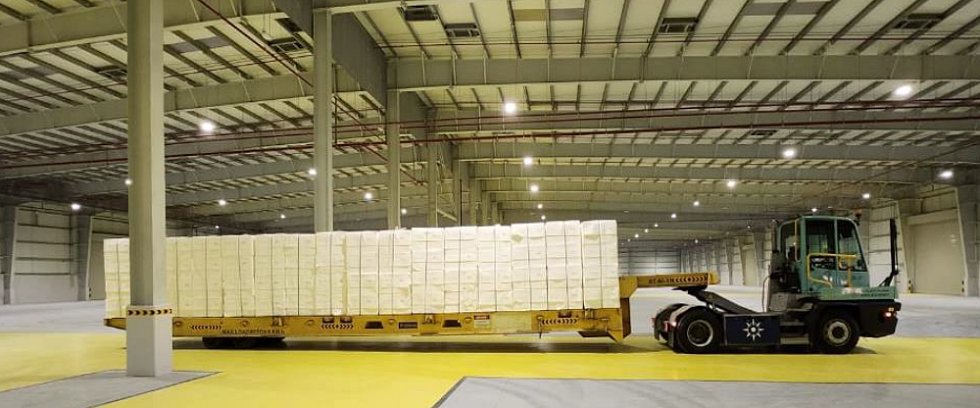
Alexander Global Logistics Opens New Country Office in United Arab Emirates
Sept. 9, 2023 - Alexander Global Logistics (AGL) in August opened a new country office in Dubai South, United Arab Emirates.
The establishment of the new country office coincides with a 10-year Strategic Partnership Agreement signed by AGL and AD Ports Group in May of 2022. According to the agreement, the two parties would collaborate to form and launch a transshipment hub in Abu Dhabi dedicated to handling pulp and paper products.
At the time of the signing of the agreement, Carsten Hellmers, CEO of AGL, said, “We are very excited about this project, as we have the strongest belief that the combination of expertise and knowledge of the industry brought into this Strategic Partnership Agreement by Alexander Global Logistics plus the unique location, abilities and resources provided by AD Ports Group will soon allow the pulp and paper industry to have a world-class terminal to serve customers in the Abu Dhabi hinterland and reach other destinations taking full advantage of the hub.”
Saif Al Mazrouei, CEO of Ports Cluster, AD Ports Group, added, “[The agreement] marks a key milestone in Khalifa Port’s ongoing development to support the UAE’s industrialisation efforts, and is also the first step in what we see as Abu Dhabi’s transformation into a regional leader for pulp and paper products.”
In November of 2022, AGL inaugurated a 30,000 square meter warehouse located less than 250 meters away from the new Port Khalifa South Quay.
AGL noted that Khalifa Port is a vital link connecting East and West trade, especially to fast growing markets such as India, Pakistan, and Turkey.
SOURCE: Alexander Global Logistics GmbH |
|
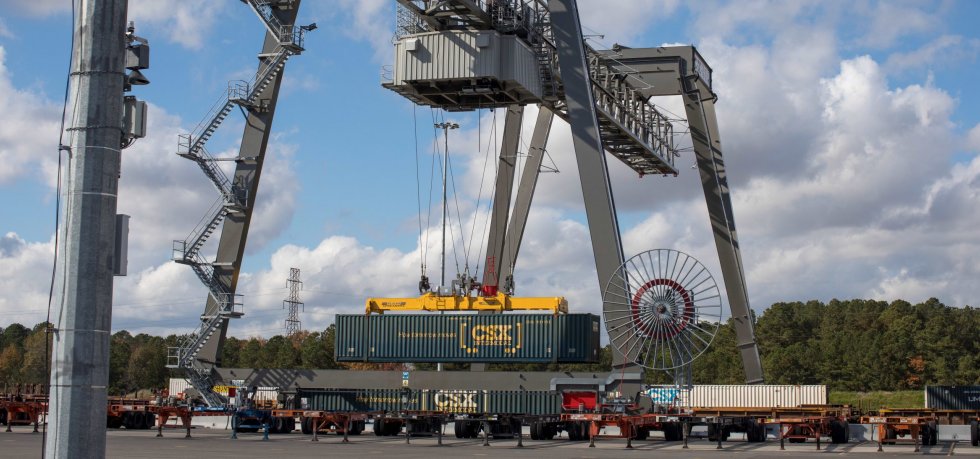
Georgia Ports Authority, CSX Offer New ‘Carolina Connector’ Service
Sept. 7, 2023 – North Carolina importers and exporters can now tap into a faster supply chain through a direct rail connection between the Port of Savannah and Rocky Mount, North Carolina via the CSX Carolina Connector (CCX) Intermodal terminal.
“This is an exciting logistics solution for existing and new customers across North Carolina,” said Georgia Ports Authority President and CEO Griff Lynch. “In collaboration with CSX, we’re offering daily access and faster service, bringing world-class port services to the doorstep of the area’s business and industry.”
The Georgia Ports Authority and CSX have teamed to provide 7-day-a-week rail departures between GPA’s Mason Mega Rail Terminal in Savannah and the Eastern North Carolina location, offering customers three-day ship-to-shore transit time.
“CSX is proud to be a part of this transformative partnership, which embodies our commitment to foster growth, connect markets and propel economic progress for the region,” said Kevin Boone, CSX Executive Vice President of Sales and Marketing. “The integration of GPA’s On-Dock Rail and the Inland Port at CCX signifies a leap forward in providing efficient, sustainable, and dynamic rail-to-truck inland port container service for our customers.”
CCX is located on an efficient, high-speed, high-capacity mainline rail route. Cargo departing the Port of Savannah is available to customers on the third day after leaving Garden City Terminal.
Faster Service
On-dock rail service expedites container handling. GPA’s Mason Mega Rail features 85 acres and 24 miles of on-terminal track, making it the largest intermodal facility on a port in the Americas with capacity to grow future cargo volumes.
Flexibility
Ample space at CCX, combined with longer-term storage options at the Port of Savannah’s new Garden City Terminal West yard will afford exporters greater scheduling flexibility.
“The GCT West yard allows importers to store retail goods or manufacturing components until they are needed, without the need to pay demurrage,” said GPA Vice President of Sales and Marketing Flavio Batista. “Similarly, exporters will be able to pre-stage their cargo on-terminal to await vessel loading.”
In Rocky Mount, CSX customers that have gate access via QR code can pick up or drop off containers on chassis seven days a week, from 8 a.m. to midnight. CSX customers that need a container lifted on or off a chassis will have access 8 a.m. to 5 p.m.
Location
CCX provides convenient, easy access to I-95 and features three wide-span, zero-emission electric cranes with a lift capacity of 110,000 containers per year. In addition to its remotely-operated electric cranes, CCX maximizes safe and efficient truck movement through the facility with CSX’s X-Gate technology, which automates the in-gate process, streamlines traffic flows and automatically inspects loads leaving the facility.
The new, state-of-the-art facility is built with security in mind, featuring berms, fences and cameras to ensure cargo security.
SOURCE: Georgia Ports Authority |
|
|